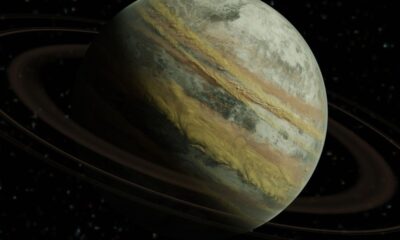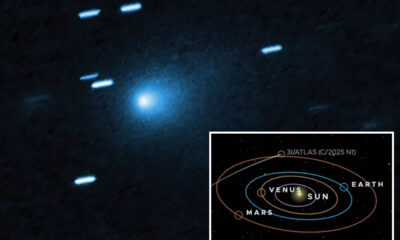Science
Interstellar Comet 3I/ATLAS Ejects Jet Toward the Sun

An interstellar comet known as 3I/ATLAS is actively ejecting ice and dust into space, according to recent observations made by astronomers. The latest images reveal a prominent jet of material directed toward the sun as the comet approaches its closest point to our star on October 30. This event marks the third time a known interstellar object has traversed our solar system.
The composite image of 3I/ATLAS displays its icy, rocky core as a dark central point, surrounded by a white glow that represents the comet’s coma, or atmosphere. The jet, highlighted in purple, extends outward toward the sun. Such behavior is consistent with that of other comets in the solar system, which also exhibit jets when they near the sun.
Astronomers noted the jet’s activity on October 15 through the Astronomer’s Telegram, a communication platform for the astronomy community overseen by Robert Rutledge, an associate professor at McGill University in Montreal. The footage capturing the jet was taken on August 2 using the Two-meter Twin Telescope at Teide Observatory in the Canary Islands. This image is a composite of 159 exposures, each lasting 50 seconds.
According to Miquel Serra-Ricart, chief science officer at the Light Bridges private research institution, the behavior observed is typical for comets. He explained that as the comet rotates, jets can fan out, with some materials remaining in the coma while others are pushed into the comet’s tail by solar wind. The jet from 3I/ATLAS is estimated to extend about 6,200 miles (approximately 10,000 kilometers) from the comet’s surface, which is more than twice the width of the largest part of the United States.
The composition of the jet likely includes carbon dioxide and dust particles, similar to what was detected by NASA’s James Webb Space Telescope in August. As comets get closer to the sun, different areas heat up at varying rates. This uneven heating can cause sublimated gases beneath the surface to burst forth, leading to the formation of jets.
These observations not only contribute to our understanding of 3I/ATLAS but also enhance our knowledge of cometary behavior as a whole. As the comet continues its trajectory, it will come within 1.8 astronomical units of Earth, allowing visibility through small telescopes before it disappears back into space.
-

 Technology5 months ago
Technology5 months agoDiscover the Top 10 Calorie Counting Apps of 2025
-

 Health3 months ago
Health3 months agoBella Hadid Shares Health Update After Treatment for Lyme Disease
-

 Health3 months ago
Health3 months agoErin Bates Shares Recovery Update Following Sepsis Complications
-

 Technology4 months ago
Technology4 months agoDiscover How to Reverse Image Search Using ChatGPT Effortlessly
-

 Technology1 month ago
Technology1 month agoDiscover 2025’s Top GPUs for Exceptional 4K Gaming Performance
-

 Technology3 months ago
Technology3 months agoElectric Moto Influencer Surronster Arrested in Tijuana
-

 Technology5 months ago
Technology5 months agoMeta Initiates $60B AI Data Center Expansion, Starting in Ohio
-

 Technology5 months ago
Technology5 months agoRecovering a Suspended TikTok Account: A Step-by-Step Guide
-

 Health4 months ago
Health4 months agoTested: Rab Firewall Mountain Jacket Survives Harsh Conditions
-

 Lifestyle5 months ago
Lifestyle5 months agoBelton Family Reunites After Daughter Survives Hill Country Floods
-

 Health3 months ago
Health3 months agoAnalysts Project Stronger Growth for Apple’s iPhone 17 Lineup
-

 Technology4 months ago
Technology4 months agoHarmonic Launches AI Chatbot App to Transform Mathematical Reasoning





















